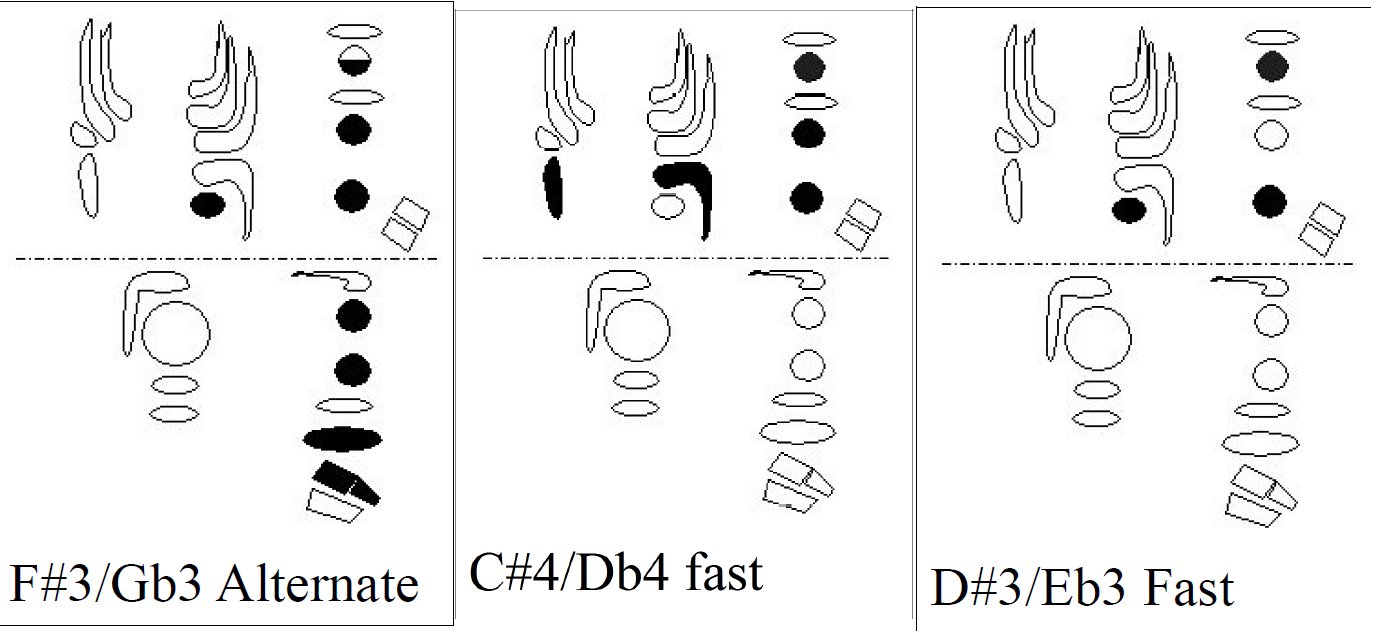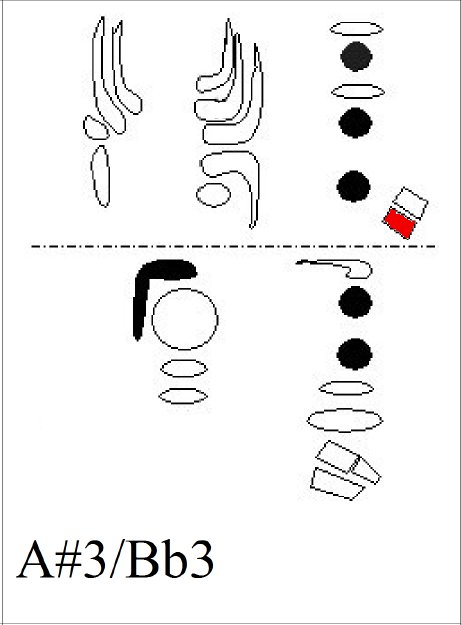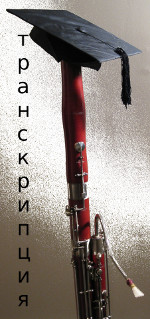Изучение этюда Nº41 Вайсенборн опус 8/2, этюд №41 для продвинутых студентов фаготистов. Аппликатура, упражнение на одной ноте и занятие по фразировке. Самый часто употрибимый стих.Терри Б. Юэлл, Цифровый Профессор Фагота. Перевод, Елена Яковлева. BDP # 149. www.2reed.net.
TUTORIAL Руководство
1. Welcome, this is Terry Ewell. I interpret the “con fuoco” marking, “with fire,” to indicate that the dotted eighth notes should be separated. This gives the performance more zeal and passion. It then contrasts nicely with the “tranquillo” section that is calmer and slurred.
1. Добро пожаловать, это Терри Юэлл. Я интерпретирую маркировку
«con fuoco», «с огнем», как указание того, что
пунктирные восьмые ноты должны быть отделены. Это дает исполнению
больше усердия и страсти. Затем, оно хорошо контрастирует с более
спокойной и певучей секцией «tranquillo».
2. В последних двух строчках «leggermente» обозначает налегке. Не акцентируйте четвертные ноты «тенуто». Это слово указывает на то, что ноты должны тянутся до конца, но не нужно выделять каждую ноту.
3. Throughout the movement I make use of the alternative Gb3 fingering when approached by or going to Bb3. I also make use of the left hand only Db4 and Eb3 fingerings. These are not marked in the music because you should be familiar with these fingerings now and when to use them.
3. На протяжении всей части я использую альтернативную аппликатуру для Сольb3, когда она появляется после или до Сиb3. Я также использую аппликатуру одной левой руку на Реb4 и Миb3. Они не отмечены в партии, потому что вы уже должны быть знакомы с этими аппликатурами и когда они используются.


4. Я также добавляю октавный клапан До #, чтобы стабилизировать и помочь интонации Сиb3 в «Fine».

5. Я использую альтернативную аппликатуру для Сольb4 в 4м такте 3й строчки. Эта аппликатура работает намного лучше для лиги от Сиb4. Это та же самая аппликатура, которую я использую во втором сольном отрывке Весны священной.

http://www.2reed.net/bdp/home.html#bdp92
6. В моих видео о «Весне священной» (BDP # 92-94) я обсуждаю этот пассаж и другие аспекты занятия этим произведением.
http://www.2reed.net/bdp/home.html#bdp92
7. Now let’s work on phrasing. In line 10 I challenge you to practice phrasing the first four measures in three different ways. This will help you to better understand the subtle roles of dynamics and rubato with phrase shapes.
7. Теперь давайте поработаем над фразировкой. В 10й строчке я призываю вас найти и поучить три разных вида фразировки. Это поможет вам лучше понять тонкие роли нюансов и рубато при формирование фраз.
8. First shape the four measures in separate one measure phrases. Do this both on a monotone and as written. The arrows point to the musical goals, so these phrases start with climaxes and are shaped away from them.
8. Сначала дайте форму этим 4м тактом, как отдельные фразы по одному такту. Поделайте это на одной ноте, а потом как написано. Стрелки указывают на музыкальные кульминации, поэтому эти фразы начинаются с кульминационных точек а потом расслабляются.
8a. That phrasing really chops up de the music. This is not a good musical choice. Now, shape the measures with the goal on the downbeat of the third measure. First I will do this on a monotone, and then as written. The arrow to the right of the curved line indicates motion toward the goal. The arrow to the left of the curved line is motion away from the goal. Thus, the downbeat of measure 3 is the climax.
8а. Эта фразировка действительно разрубает музыку. Это не хороший музыкальный выбор. Теперь сформируйте такты с целью на первой доле третьего такта. Сначала я поделаю это на одной ноте, а потом как написано. Стрелка справа от линии указывает движение к цели. Стрелка слева от линии является движением от цели. Таким образом, 1я доля 3го такта является кульминацией.
8b. Finally, shape the measures with the goal on the downbeat of the fourth measure. Again, I will practice it with a monotone, and then as written.
8b. Теперь, сформируйте такты с целью на первой доле четвертого такта. Опять же, я поделаю это на одной ноте, а за тем как написано.
8c. Which of the last two phrasings did you like the most? Why?
In the next line Weissenborn indicates, with dynamics, a goal on the downbeat of the third measure. However, since the goal in the next four measures in line 10 is on the forth measure downbeat, you could prepare the listener for that by phrasing to the fourth measure in line 10. Then in the 11th line, your goals could be placed on the downbeat of the third measure of each pair.
8с. Какие из этих двух фразировок вам понравились больше всего? Почему?
В следующей строчке Вайссенборн указывает, нюансоми, цель на первой доле третьего такта. Однако, поскольку цель в следующих четырех тактах в 10й строчке находится в четвертом такте, вы можете подготовить слушателя к этому, и фразировать в четвертый такт оба раза. Затем в 11-й строке ваши цели могут быть помещены на первой доли третьего такта.
8d. Both solutions for line 10 (that is, goals on the downbeat of the third or fourth measures) are musically good. It will be your decision as the musician to choose what you want to express here. However, be prepared to defend your choices. Don´t just hope that on the spur of the moment you come up with a good phrasing. Think through your choices and be ready with a reply if someone asks you, “why did you phrase like that?”
8d. Оба решения для 10й строки (цели на первой доли третьего или четвертого такта) музыкально хороши. Как музыкант, вы решите, что вы хотите выразить в этом месте. Однако будьте готовы отстаивать свой выбор. Не надейтесь, что на выступлении вы придумаете хорошую фразировку. Подумайте хорошо и будьте готовы ответить, если кто-то спросит у вас: «Почему вы так сфразировали?»



REFLECTION Размышление
9. What is the most recited verse in the entire Bible? If you said, “John 3:16” you might be partially correct. That is perhaps the most translated verse in all of human history. It appears in more languages than any other portion of literature. However, my question was about which verse is the most recited.9. Какой стих наиболее употрибимый из всей Библии? Если вы сказали «Иоанна 3:16», вы частично правы. Это, пожалуй, самый переводимый стих из всей истории человечества. Он появляется на большем количестве языков, чем любая другая часть литературы. Однако мой вопрос был о том, какой стих является наиболее употрибимым.
10. For centuries Jews and even the first Christians recited the “Sh’ma Yisrael,” ( יִשְׂרָאֵל שְׁמַע) translated as “Hear, O Israel.” A portion of this is found in Deuteronomy 6:4-5. For centuries believers have recited these words at least two times a day:
10. На протяжении веков евреи и даже первые христиане произносили «Sh’ma Yisrael» (יִשְׂרָאֵל שְׁמַע) что обозначает «Слушай, Израиль». Часть этого можно найти во Второзаконии 6: 4-5. Веками верующие повторяли эти слова по крайней мере два раза в день:
11. Hear, O Israel, the LORD our God, the LORD is one. You shall love the LORD your God with all your heart, with all your soul, and with all your strength. (NKJV, Deuteronomy 6:4-5)
11. Слушай, Израиль! Господь наш Бог, – единый Господь. Люби Господа, Бога твоего, всем сердцем твоим, всей душой твоей и всеми силами твоими. (NRT, Второзаконие 6: 4-5)
12. Jesus was asked by a legal authority, “What is the greatest commandment of all?” He answered with a portion of the Sh’ma Yisrael, but made one change. He replied:
12. Прокурор спросил Иисуса: «Какая самая великая заповедь из всех?» Он ответил частью Sh’ma Yisrael, но внес в него одно изменение. Он ответил:
13. ‘You shall love the LORD your God with all your heart, with all your soul, with all your strength, and with all your mind… (NKJV, Luke 10:27)
13. Люби Господа, Бога твоего, всем сердцем твоим и всей душой твоей, всей силой твоей и всем разумом твоим... (NRT, Луки 10:27)
14. I find the addition of the portion “with all your mind” very interesting. There is no question that Jesus was a brilliant man. But the addition of this portion is not just for the smartest people. Jesus is indicating that God desires devotion and love from every portion of our being. He wants all of you: your emotions, your actions, and your thoughts.
14. Я нахожу добавление слов «всем своим разумом» очень интересным. Нет сомнений, что Иисус был очень умным человеком. Но добавление этой части не только для самых умных людей. Иисус указывает, что Бог желает преданности и любви от каждой части нашего существа. Он хочет вас целиком: ваше эмоции, ваше действия и ваше мысли.
